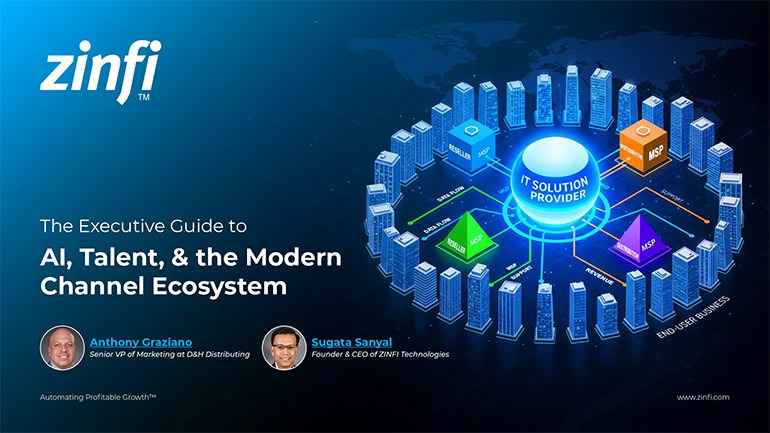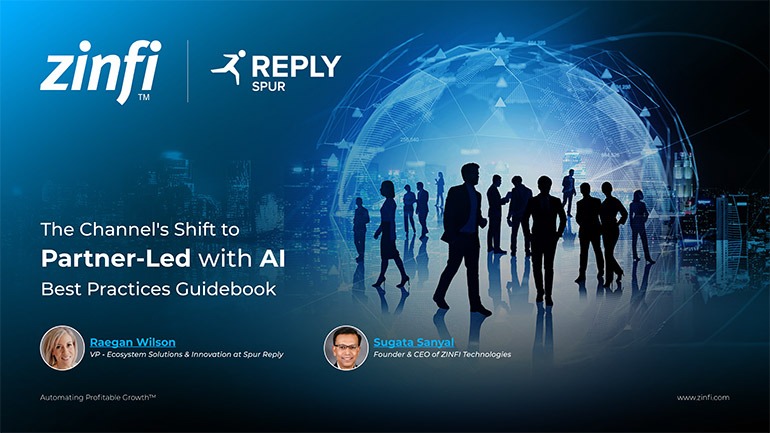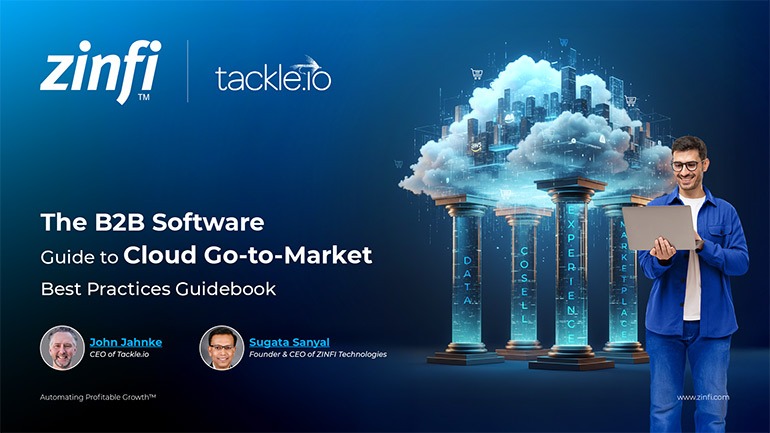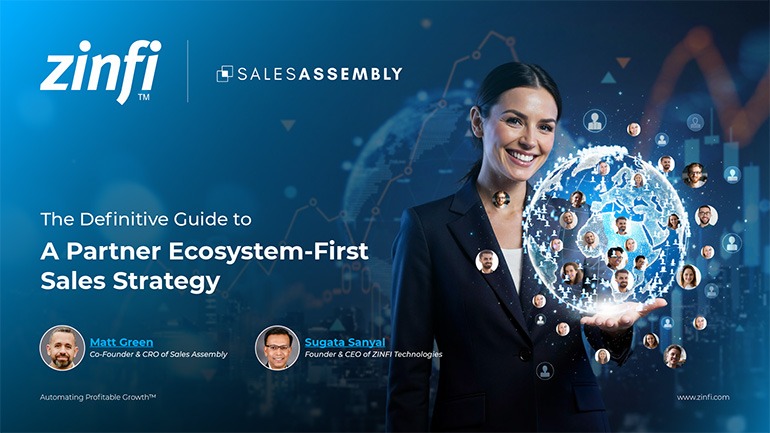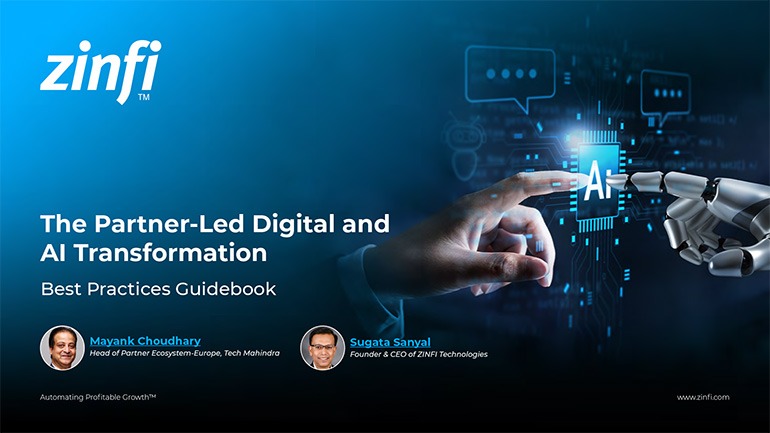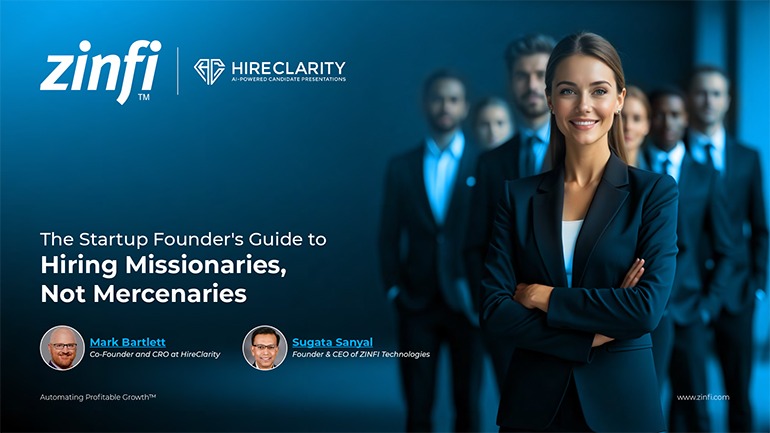

- Panel 1: PartnerOps Defined: The New Operating Framework
- Panel 2: PartnerOps in Action: Co-Market, Co-Sell & Incentivize
Panel 1: PartnerOps Defined: The New Operating Framework
PartnerOps Defined: The New Operating Framework
In today’s complex and rapidly evolving business landscape, Partner Operations (PartnerOps) is a critical discipline for organizations aiming to maximize their indirect revenue channels and scale their partner ecosystems. While often discussed in fragments, a clear, unified definition and operating framework for PartnerOps remains elusive. This panel discussion dives deep into what PartnerOps truly means, how it drives strategic alignment and efficiency, and why it’s indispensable for achieving sustained growth in the age of AI.
Join Sugata Sanyal, Founder & CEO of ZINFI, as he hosts an expert panel in Denver featuring:
- Jason Glass, Sr. VP of Global Partnerships, SugarCRM
- Rachael Travis, Director, Global Partner Programs, Smartsheet
- Justin Zimmerman, CEO, partnerplaybooks.com
- Rachel Collie, Director of Technology Partnerships, Unanet
These leaders from diverse enterprise organizations and agencies combine decades of collective experience in partnership sales, technology alliances, and global partner programs. They share their insights on defining PartnerOps, building effective partner strategies from scratch or inheriting complex ecosystems, optimizing partner recruitment and enablement, and the transformative role of AI in streamlining Partner Operations for unparalleled scale and performance.
Watch the complete panel discussion to gain actionable insights into defining and leveraging PartnerOps for your organization’s success!
Panel Focus: PartnerOps Defined: The New Operating Framework
The concept of PartnerOps is a relatively new and evolving discipline within the business world, lacking a universally accepted definition or published framework. Unlike established fields like DevOps or RevOps, PartnerOps is still in its nascent stages of formalization, leading to varied interpretations across different organizations. However, a common thread emerging from practice suggests that PartnerOps fundamentally involves strategically allocating resources to move a partner ecosystem from its current state to a desired, more effective one. This encompasses a structured approach to managing the entire partner lifecycle, from initial strategy and recruitment to ongoing enablement and performance measurement. Larger companies with significant indirect revenue often have dedicated PartnerOps functions, while smaller organizations may embed these responsibilities within broader Revenue Operations. The goal is to bring capacity, automation, and tools to the partner function, similar to how DevOps transformed software development over 15 years.
Strategic leaders begin by building a contextual understanding of the partner ecosystem’s history and current state when they enter it. Partners often hold their breath as new leadership arrives, eager to grasp shifting priorities and potential changes. This initial phase involves a “listening tour” to honor past efforts, understand existing talent, and identify key drivers within the organization. Examining what the inherited ecosystem does exceptionally well is crucial, such as delivering bespoke solutions to enterprise customers and pivoting programs to leverage those strengths. For example, a global business with multiple go-to-market motions might realize its structure is too complex for its size and need to identify core strengths to focus on for competitive advantage.
Ultimately, internal alignment is paramount for the success of PartnerOps. While similarities exist between military and corporate strategies – both involve defining a mission and allocating resources to achieve a goal – key differences lie in motivations and alignment. Unlike an army unit where roles are clearly defined and camaraderie drives unified execution, corporate functions (e.g., sales, marketing, product) may have differing objectives. Therefore, a key task for PartnerOps leadership is to “weave those webs” and ensure everyone understands how the partner team contributes to broader success and scale. This strategic context-setting and internal alignment are foundational before proceeding to recruitment and enablement efforts. This ensures that PartnerOps is integrated into the wider business strategy and has the necessary organizational buy-in.
Partner recruitment strategies have evolved significantly, moving from a broad “spray and pray” approach to highly targeted, data-driven methods focused on finding partners with precise alignment and a mandate to succeed. When working with clients on recruitment, the initial focus is often on a singular outcome: leads and pipeline. However, successful recruitment necessitates a deeper “discovery work” to identify partners who match an Ideal Customer Profile (ICP) and those with an organizational mandate and genuine excitement to perform the required work. This critical early-stage validation helps avoid investing in partners who may not be truly committed or capable of driving results. Webinars and events can serve as valuable “litmus tests” to assess a partner’s responsiveness, alignment, and internal buying power before entirely investing. This approach reveals clear winners, often following a 95/5 ratio, highlighting the few high-performing partners that might otherwise go undiscovered.
Finding new partners often leverages internal channels and customer insights. Running onboarding surveys that ask new partners how they heard about the company or what indispensable tools are in their tech stack can reveal valuable sources of leads. Crucially, asking customers about their essential tools or pain points can uncover potential PartnerOps opportunities that align with existing market demand. Vendors use this customer-centric approach to partner recruitment to validate potential overlaps and alignment, ensuring they focus on partners who can solve customer challenges alongside their offerings. This external listening is becoming table stakes for building multi-party plays as customers increasingly demand integrated solutions rather than single tools.
For organizations operating with limited dedicated PartnerOps marketing resources, such as one panelist described for their verticalized focus, partner recruitment can resemble an SDR’s cold outreach process. This involves extensive research on target companies, crafting personalized pitches, and leveraging social selling on platforms like LinkedIn to make initial inroads. While vertical-specific companies may already recognize the value, more horizontal targets require greater effort to demonstrate the value proposition, emphasizing high customer retention rates, well-developed APIs, and strong joint customer bases. Mass outreach can be more automated for affiliates and lower-touch partners, focusing on simple messaging derived from customer value and competitive intelligence. However, for higher-touch alliances, the approach is more hands-on, involving in-person meetings and personalized follow-ups to build deep relationships and demonstrate a willingness to go “beyond what other people are doing.” Regardless of the scale or touch, the underlying principle is to orchestrate data collection and outreach to deliver relevant, personalized communications that benefit all parties, moving beyond mass “spray and pray” marketing.
Organizations use partner enablement to onboard partners effectively and continuously equip them to deliver value and drive revenue. Formal partner enablement may initially be non-existent or underdeveloped in many organizations, particularly those in a rapid growth phase or with lean teams. The challenge is building a comprehensive program beyond one-time training to provide ongoing consultation and support. Tools leveraging AI, such as visual playbook creators with avatar technology, can significantly deliver engaging and consistent enablement messaging to a global partner framework for new and existing partners. These technologies help overcome resource constraints, making it feasible to scale enablement even with razor-thin teams.
A key aspect of effective partner enablement involves structuring content in an easily consumable and role-based manner. This means offering short, focused courses (30 minutes to an hour) tailored to specific partner roles (e.g., technical implementers, sales reps). Incorporating practical assessments and one-on-one sessions with internal technical experts further reinforces learning and ensures partners can apply their knowledge effectively in real-world scenarios. Formalizing enablement as a program requirement for existing partners can significantly boost engagement, as partners often welcome structured guidance on improving their performance and understanding their path to higher tiers. This proactive approach frees Partner Account Managers (PAMs) from chasing underperforming partners, allowing them to focus on cultivating high-potential relationships and recruiting new partners that align with successful profiles.
The enablement strategy must also address the partner relationship’s market-facing (co-marketing, co-selling) and technical sides. On the market side, this involves providing web listings, webinars, and other collateral and, crucially, identifying joint customers where co-selling can occur. However, introducing co-selling to direct sales teams can be challenging, as salespeople often prefer to operate as “lone wolves.” It requires finding internal sales leaders who champion the value of technology integration partnerships in increasing deal velocity, win rates, and deal size. On the technical front, partners need access to sandboxes, APIs, and product functionality to build and test integrations, often requiring the vendor to loan internal product resources due to the absence of dedicated partner technical consultants. This multifaceted enablement, encompassing both commercial and technical aspects, is essential for ensuring active PartnerOps and avoiding “dormant” partnerships that merely exist as logos on a website. The constant re-evaluation and potential “pruning” of partners who don’t fit the strategic vision are necessary for maintaining a high-performing ecosystem.
The future of PartnerOps is poised for a significant transformation through the strategic adoption of AI and automation, particularly as organizations face increasing demands without proportional increases in human resources. AI agents’ most immediate and realistic application in PartnerOps is automating tactical inbound inquiries from partners, such as requests for data sheets, password resets, or lead submission guidance. This frees human teams from low-value, high-volume tasks, which can consume 15-20 hours per week per person, allowing them to focus on more strategic work. Secondly, AI agents can play a crucial role in sales coaching within reseller ecosystems, helping partners become more proficient at messaging and sales sequencing, thereby augmenting the work that human teams currently struggle to scale.
Beyond basic inquiries, AI agents can act as “matchmakers” for direct sales teams, proactively identifying the right partner for the right customer and need by leveraging vast amounts of partner expertise data. This eliminates the manual effort of busy sales teams trying to locate partners and ensures that PartnerOps insights surface directly within CRM systems like Salesforce on active opportunities. AI can also support partners in structuring deals and developing statements of work by mining existing customer contracts and sales call recordings to provide templated solutions (e.g., 75-80% ready). For a “team of one” managing extensive partner portfolios, AI agents would be invaluable for “keeping the lights on,” automating content updates, and even evaluating new technology partners based on predefined criteria, significantly streamlining strategic decision-making and recruitment.
Achieving effective PartnerOps and securing the necessary resources often hinges on C-suite involvement and alignment. Leaders must “breadcrumb” their CEO or CRO, consistently informing them about partner initiatives, their rationale, and resource needs, potentially through executive dashboards and KPIs. Critically, it’s about having a strong advocate at the executive table who can champion the PartnerOps team’s value and influence resource allocation. This requires defining what “partner” means to leadership, addressing any biases (e.g., affiliate marketing focus), and clarifying what is realistically possible based on product type and pricing model. While some leaders may initially prefer autonomy to build under the radar, reaching a point of needing significant product investments (e.g., for MSP programs or new integrations) necessitates strong C-suite understanding and support to unlock the full potential of PartnerOps.
Panel 2: PartnerOps in Action: Co-Market, Co-Sell & Incentivize
PartnerOps in Action: Co-Market, Co-Sell & Incentivize
Executing a high-performing partner program demands more than strategy; it requires seamless co-market, co-sell, and incentive mechanisms that drive real results. This panel dives deep into the operational intricacies of effective channel execution, revealing how leading organizations scale their global partner initiatives and foster mutual profitability.
Join Sugata Sanyal, Founder & CEO of ZINFI, as he hosts an expert panel in Denver featuring:
- Kristin Carnes, Vice President, Global Channel Operations, Programs and Strategy, Netscope
- Craig Patterson, Global Channel Chief, Exabeam
- Heather K. Margolis, Founder & CEO, Channel Maven
These seasoned leaders bring extensive expertise in rebuilding, relaunching, and executing global channel organizations. They share their insights on navigating regional complexities, aligning disparate programs, evolving incentive structures, and leveraging technology—including AI—to manage partners for optimal performance and accelerated growth.
Watch the complete panel discussion to uncover the tactical playbooks for driving PartnerOps success in co-marketing, co-selling, and incentivizing your channel!
Panel Focus: PartnerOps in Action: Co-Market, Co-Sell & Incentivize
Executing a global partner program at scale is a formidable challenge, especially when inheriting an ecosystem characterized by fragmented and inconsistent regional initiatives. One common scenario involves organizations where each region, theater, or country has developed its distinct partner program, often documented only on paper and lacking operationalized processes. The initial step for leaders taking on such a role is to conduct a comprehensive assessment, analyze what each team is doing, evaluate operational effectiveness, and determine which initiatives yield results. This meticulous discovery process is crucial for understanding the current state and identifying opportunities for standardization and optimization.
The primary goal of this harmonization effort is to ensure a predictable and profitable experience for partners, regardless of their selling location. This often involves consolidating disparate programs into a standardized, globally consistent tiered structure. Simultaneously, leaders might operationalize new pricing structures and directly embed standardized discounts and deal registration incentives into systems to eliminate manual, inconsistent applications. This shift from ad-hoc processes to automated, system-driven workflows is vital for reducing administrative burden, ensuring fairness, and building partner trust by providing transparency and predictability in their financial engagements.
Beyond internal operational alignment, defining a clear channel strategy is paramount, particularly for companies backed by private equity. Such firms often require channel leaders to understand and align with specific operational goals and KPIs. This necessitates extensive collaboration with key internal stakeholders, including finance, marketing, and revenue officers, to ensure the channel program directly contributes to overarching corporate objectives. Additionally, it’s critical to understand how the company is perceived in the market by engaging in intentional, one-on-one conversations with strategic partners globally. This qualitative feedback, supplemented by broad partner surveys, helps identify common themes and regional nuances, guiding the necessary fixes and adaptations to build and launch a new, high-performing global program.
Partner marketing has transformed dramatically from the “spray and pray” tactics of a decade ago, where mass email blasts and generic events were the norm, to highly integrated and personalized precision engagement. Historically, marketing campaigns were often “campaigns in a box,” delivered identically across hundreds of partners, leading to ineffective results and damaging partners’ SEO. Today, the focus is on enabling partners to provide customized messaging that highlights their unique business value augmented by the vendor’s technology rather than just generically promoting the vendor’s product.
The shift in buyer behavior means traditional methods like telemarketing and untargeted email blasts are largely ineffective. Instead, modern partner marketing emphasizes multi-channel approaches that prioritize relevance and personalization. This includes leveraging platforms like LinkedIn for highly targeted social posts and cadences, utilizing AI for AEO (AI Engine Optimization) to optimize content for voice searches and conversational AI, and creating engaging blog posts that blend partner services, tech, and vendor technology. Email, once primary, is now a follow-on tool used strategically for specific, qualified engagements.
Events have also evolved from being ends in themselves to integrated components of longer, meticulously curated campaigns. Modern events are not about sheer volume (e.g., golf outings that “don’t drive demand”) but highly targeted experiences designed to attract specific decision-makers with high intent. An example highlighted involves exclusive events (like driving luxury cars on a racetrack) that quickly draw qualified contacts. This precision-focused approach uses AI tools to understand buyer intent and create highly personalized campaigns for specific contacts within target accounts. It’s about being creative and strategic to avoid throwing “good money at bad events,” ensuring every marketing effort contributes to measurable pipeline and revenue.
Partner incentives have moved beyond simple, standardized MDF catalogs and basic commissions to more nuanced, tiered structures designed to drive specific partner behaviors and ensure profitability. While traditional mechanisms like upfront discounts and backend rebates remain, the key is to tailor them intentionally based on the partner’s type, role in the ecosystem, and regional maturity. For example, expectations for MDF usage might differ significantly across emerging markets like ASEAN compared to established regions. Transparency and rigorous ROI tracking are paramount, ensuring that every dollar spent in co-marketing is directly associated with deal registration, pipeline, and revenue. This data-driven approach allows organizations to prove the return on investment for their incentive programs.
Co-selling motions are becoming increasingly critical, but face an uphill battle against many direct salespeople’s “lone wolf” mentality. To overcome this, vendors must actively “retool” their sales teams, educating them on the intelligence and deal acceleration benefits technology partners can provide. The focus is demonstrating how partners can augment direct sales efforts, improving win rates, deal velocity, and average deal size. Tools like Crossbeam are essential for identifying account overlaps and white space, allowing vendors to approach partners strategically with specific co-sell plays for targeted accounts. Successful co-selling often involves a broad ecosystem approach, where a GSI might influence a deal, alliance partners provide deep integrations, and resellers uncover initial opportunities, all contributing to a multi-party transaction.
Beyond financial incentives, non-monetary rewards are crucial in driving desired partner behaviors. Innovative programs, like offering branded merchandise directly to individual sellers for deal registrations (e.g., custom Air Jordan sneakers), can create excitement, foster brand awareness, and encourage repeatable actions far more effectively than a generic check to the partner company. The goal is to make incentives visible and directly tied to individual performance, ensuring sellers understand why they received a reward so they can replicate the behavior. This behavioral psychology, combined with tiered program structures that unlock better discounts and service opportunities based on certification levels and sales targets, incentivizes consistent performance and commitment. Measuring these impacts through rigorous KPIs—such as pipeline creation, sales bookings, certification levels, and program engagement—is vital for communicating success to the C-suite and continuously optimizing the Partner Program.
The future of Partner Operations is increasingly reliant on leveraging AI and automation to overcome resource constraints and drive greater efficiency. Many PartnerOps teams spend a significant portion of their time (e.g., 15-20 hours per week per person) on low-value administrative tasks like answering inbound inquiries or resetting passwords. These are prime candidates for AI automation. AI agents can act as tier-one support, instantly resolving tactical issues and freeing up human teams for more strategic activities. Beyond basic support, AI can significantly augment PartnerOps by assisting with sales coaching within reseller ecosystems, helping partners refine messaging and sales sequencing for improved deal flow.
AI also holds transformative potential in facilitating partner matchmaking for direct sales teams, proactively identifying the “right partner for the right customer for the right need” by analyzing extensive partner expertise data. This ensures that sales teams, often “busy and distractible,” are directly presented with relevant partner insights within their CRM on active opportunities. Furthermore, AI agents can streamline the creation of crucial documentation like Statements of Work (SOWs) for new partners, mining existing customer SOWs to provide templated solutions (e.g., 75-80% ready), accelerating the onboarding and activation of new partners and reducing friction in deal cycles. For strategic decision-making, AI can automate the evaluation of potential new partners, ranking them against predefined criteria and providing summarized insights for leadership review.
Securing C-suite involvement and strategic alignment is critical for PartnerOps’ success and resource allocation. While individual leaders may initially build programs with autonomy “under the radar,” reaching a point where significant product investments or broad organizational changes are needed necessitates executive buy-in. It’s crucial to “breadcrumb” the CEO, CRO, and other board members with consistent updates, demonstrating the quantifiable impact of the partner program through executive dashboards and KPIs. Like a Chief Innovation Officer, a strong internal advocate can champion the PartnerOps team’s value to the C-suite, influencing resource allocation and ensuring the partner program is recognized as a strategic asset. Overcoming C-suite biases about what “partner” means—especially if their background is limited to a single partner type—is vital for building a unified vision and unlocking the full potential of PartnerOps for sustained ecosystem growth.

